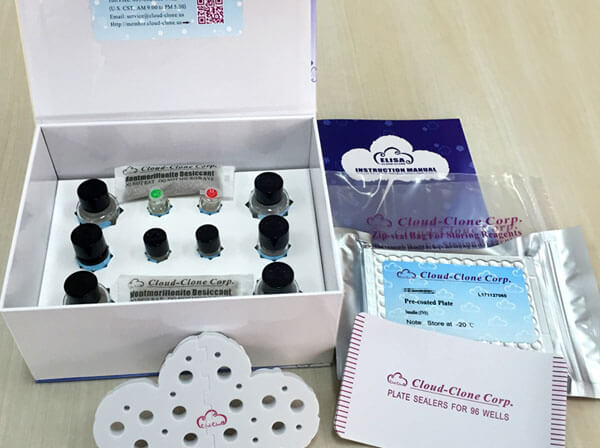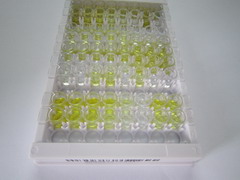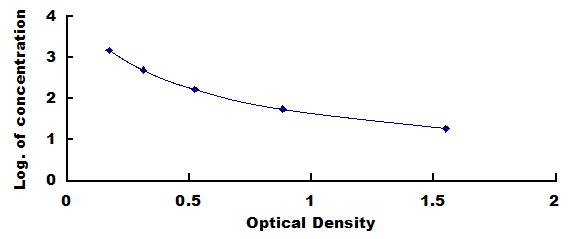ELISA Kit for Glucagon (GCG) 

GC; GLP1; GLP2; GRPP; Glicentin-Related Polypeptide; Glucagen; Oxyntomodulin; Incretin hormone
- UOM
- FOB US$ 479.00 US$ 684.00 US$ 3,078.00 US$ 5,814.00 US$ 47,880.00
- Quantity
Overview
Properties
- Product No.CEB266Mu
- Organism SpeciesMus musculus (Mouse) Same name, Different species.
- ApplicationsEnzyme-linked immunosorbent assay for Antigen Detection.
Research use only - DownloadInstruction Manual
- CategoryEndocrinology
Sign into your account
Share a new citation as an author
Upload your experimental result
Review

Contact us
Please fill in the blank.
Recovery
Matrices listed below were spiked with certain level of recombinant Glucagon (GCG) and the recovery rates were calculated by comparing the measured value to the expected amount of Glucagon (GCG) in samples.
| Matrix | Recovery range (%) | Average(%) |
| serum(n=5) | 97-104 | 101 |
| EDTA plasma(n=5) | 84-101 | 91 |
| heparin plasma(n=5) | 97-105 | 102 |
Precision
Intra-assay Precision (Precision within an assay): 3 samples with low, middle and high level Glucagon (GCG) were tested 20 times on one plate, respectively.
Inter-assay Precision (Precision between assays): 3 samples with low, middle and high level Glucagon (GCG) were tested on 3 different plates, 8 replicates in each plate.
CV(%) = SD/meanX100
Intra-Assay: CV<10%
Inter-Assay: CV<12%
Linearity
The linearity of the kit was assayed by testing samples spiked with appropriate concentration of Glucagon (GCG) and their serial dilutions. The results were demonstrated by the percentage of calculated concentration to the expected.
| Sample | 1:2 | 1:4 | 1:8 | 1:16 |
| serum(n=5) | 79-101% | 87-104% | 89-97% | 78-99% |
| EDTA plasma(n=5) | 94-102% | 79-102% | 91-99% | 91-105% |
| heparin plasma(n=5) | 78-99% | 85-93% | 85-99% | 94-102% |
Stability
The stability of kit is determined by the loss rate of activity. The loss rate of this kit is less than 5% within the expiration date under appropriate storage condition.
To minimize extra influence on the performance, operation procedures and lab conditions, especially room temperature, air humidity, incubator temperature should be strictly controlled. It is also strongly suggested that the whole assay is performed by the same operator from the beginning to the end.
Reagents and materials provided
| Reagents | Quantity | Reagents | Quantity |
| Pre-coated, ready to use 96-well strip plate | 1 | Plate sealer for 96 wells | 4 |
| Standard | 2 | Standard Diluent | 1×20mL |
| Detection Reagent A | 1×120µL | Assay Diluent A | 1×12mL |
| Detection Reagent B | 1×120µL | Assay Diluent B | 1×12mL |
| TMB Substrate | 1×9mL | Stop Solution | 1×6mL |
| Wash Buffer (30 × concentrate) | 1×20mL | Instruction manual | 1 |
Assay procedure summary
1. Prepare all reagents, samples and standards;
2. Add 50µL standard or sample to each well.
And then add 50µL prepared Detection Reagent A immediately.
Shake and mix. Incubate 1 hour at 37°C;
3. Aspirate and wash 3 times;
4. Add 100µL prepared Detection Reagent B. Incubate 30 minutes at 37°C;
5. Aspirate and wash 5 times;
6. Add 90µL Substrate Solution. Incubate 10-20 minutes at 37°C;
7. Add 50µL Stop Solution. Read at 450 nm immediately.

Test principle
This assay employs the competitive inhibition enzyme immunoassay technique. A monoclonal antibody specific to Glucagon (GCG) has been pre-coated onto a microplate. A competitive inhibition reaction is launched between biotin labeled Glucagon (GCG) and unlabeled Glucagon (GCG) (Standards or samples) with the pre-coated antibody specific to Glucagon (GCG). After incubation the unbound conjugate is washed off. Next, avidin conjugated to Horseradish Peroxidase (HRP) is added to each microplate well and incubated. The amount of bound HRP conjugate is reverse proportional to the concentration of Glucagon (GCG) in the sample. After addition of the substrate solution, the intensity of color developed is reverse proportional to the concentration of Glucagon (GCG) in the sample.
Giveaways
Increment services
Citations
- PER2 promotes glucose storage to liver glycogen during feeding and acute fasting by inducing Gys2 PTG and GL expressionPubMed: PMC3773838
- Increasing glucagon secretion could antagonize the action of exogenous insulin for glycemic control in streptozocin-induced diabetic rhesus monkeys.Pubmed: 23760004
- Specificity and sensitivity of commercially available assays for glucagon and oxyntomodulin measurement in humanEje-online: Source
- IL-21 is a major negative regulator of IRF4-dependent lipolysis affecting Tregs in adipose tissue and systemic insulin sensitivityPubmed:24430438
- Enzogenol improves diabetes-related metabolic change in C57BL/KsJ-db/db?mice, a model of type 2 diabetes mellitusPubmed:24611864
- Subcutaneous administration of liraglutide ameliorates learning and memory impairment by modulating tau hyperphosphorylation via the glycogen synthase kinase-3尾 pathway in an amyloid 尾 protein induced alzheimer disease mouse modelPubmed:27131827
- The glucoreCavia (Guinea pig )latory response to high-intensity aerobic exercise following training in rats with insulin-treated type 1 diabetes mellitusPubmed:27175938
- Subcutaneous liraglutide ameliorates methylglyoxal-induced Alzheimer-like tau pathology and cognitive impairment by modulating tau hyperphosphorylation and glycogen synthase kinase-3β.pubmed:28337257
- Vitamin D3 intake as regulator of insulin degrading enzyme and insulin receptor phosphorylationin diabetic rats.pubmed:27930980
- Ginsenoside Rg5 attenuates hepatic glucagon response via suppression of succinate-associated HIF-1α induction in HFD-fed micepubmed:28280902
- Effects of Acute Cold Stress on Liver O-GlcNAcylation and Glycometabolism in MicePubmed: 30231545
- Exogenous obestatin decreases beta-cell apoptosis and alfa-cell proliferation in high fat diet and streptozotocin induced type 2 diabetic ratsPubmed: 30776368
- Regulating glycolysis, the TLR4 signal pathway and expression of RBM3 in mouse liver in response to acute cold exposurePubmed: 30821572
- Effects of Cold-inducible RNA-binding Protein (CIRP) on Liver Glycolysis during Acute Cold Exposure in C57BL/6 MicePubmed: 30909542
- Liraglutide Combined with Human Umbilical Cord Mesenchymal Stem Cell Transplantation inhibits beta‐cells apoptosis via mediating the ASK1/JNK/BAX pathway in Pubmed: 31411368
- In vitro expansion of pancreatic islet clusters facilitated by hormones and chemicalsPubmed: 32284878
- Mice with nucleus tractus solitarius injury induced by chronic restraint stress present impaired ability to raise blood glucose and glucagon levels when blood glucose …Pubmed: 32249244
- RFRP-3, the Mammalian Ortholog of GnIH, Is a Novel Modulator Involved in Food Intake and Glucose HomeostasisPubmed: 32328034
- Acarbose ameliorates spontaneous type‑2 diabetes in db/db mice by inhibiting PDX‑1 methylationPubmed: 33236139
- Modulatory role of imatinib mesylate on pancreatic β-cells' secretory functions in an STZ rat model of diabetes mellitusPubmed: 32710900
- Mof acetyltransferase inhibition ameliorates glucose intolerance and islet dysfunction of type 2 diabetes via targeting pancreatic α-cells34391847

















